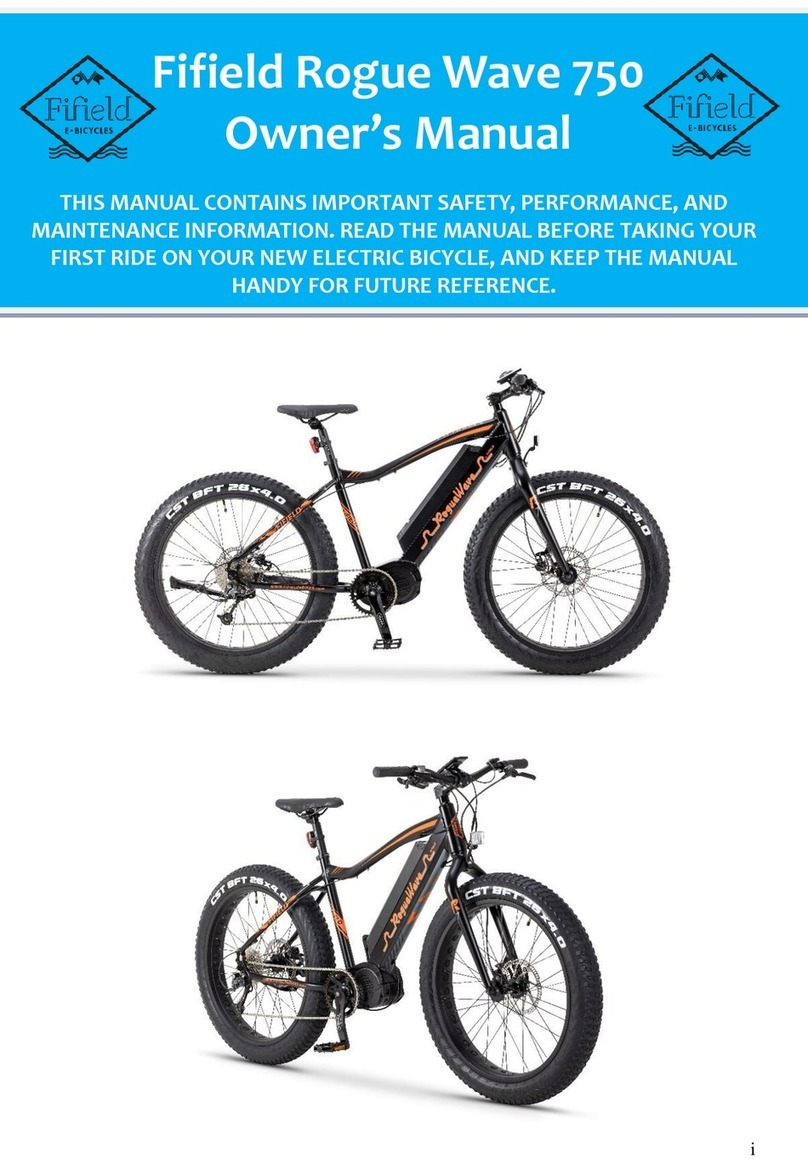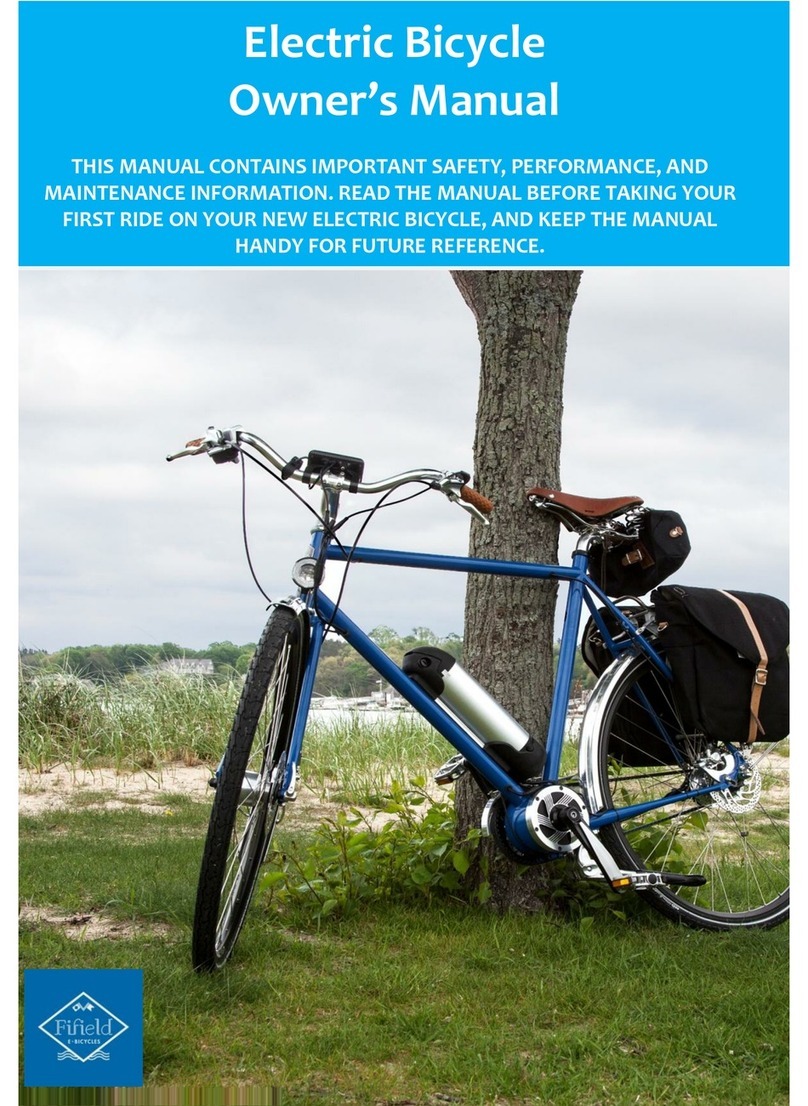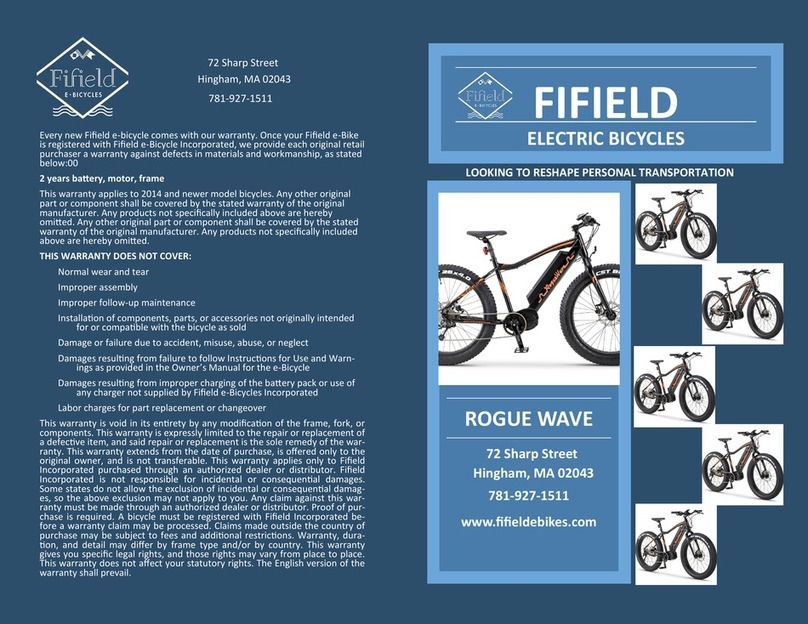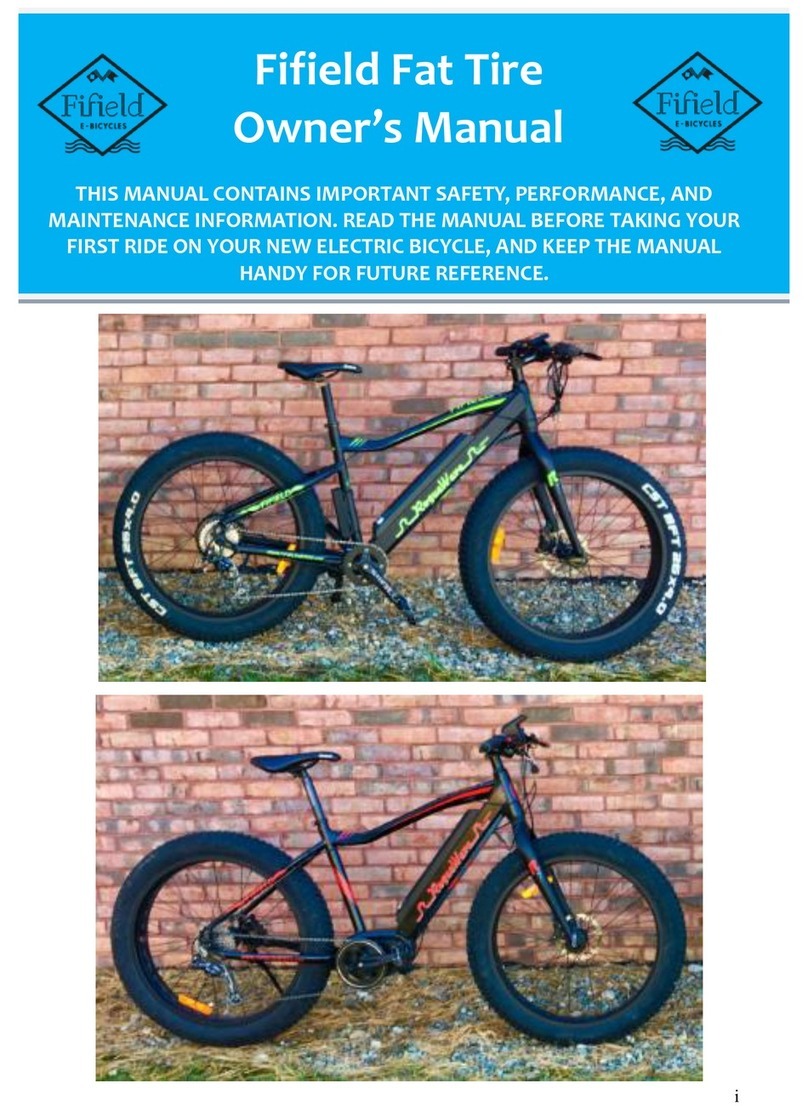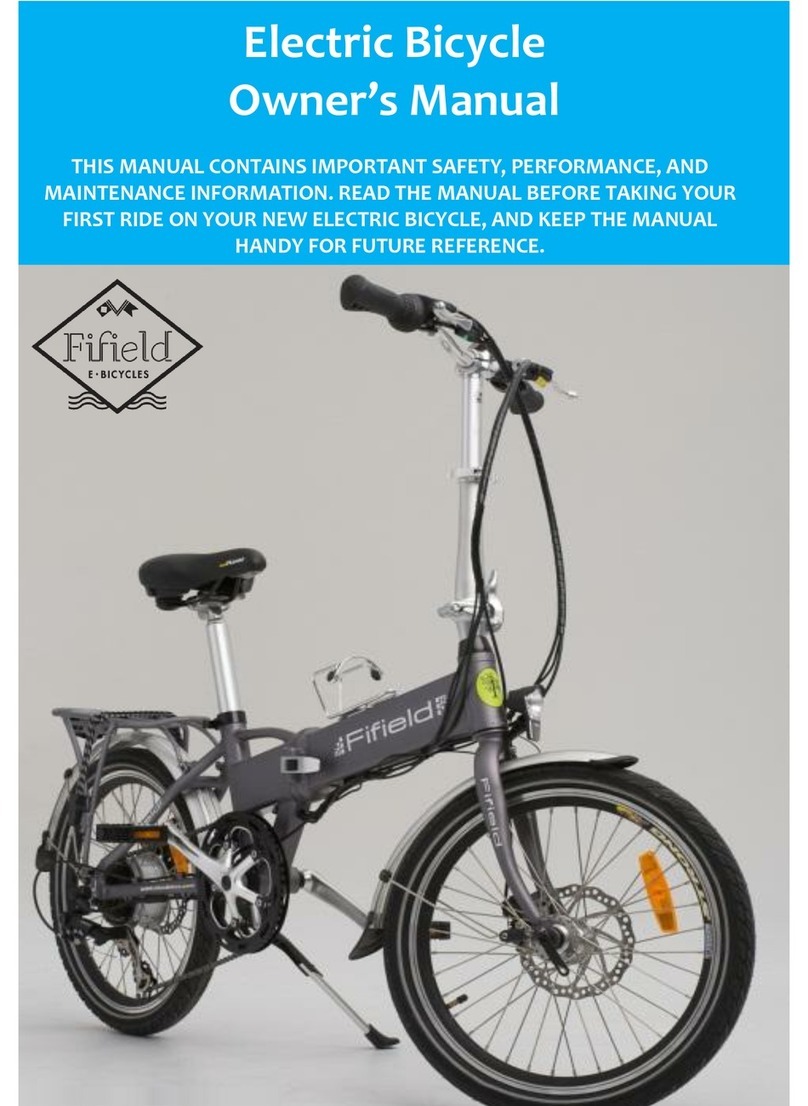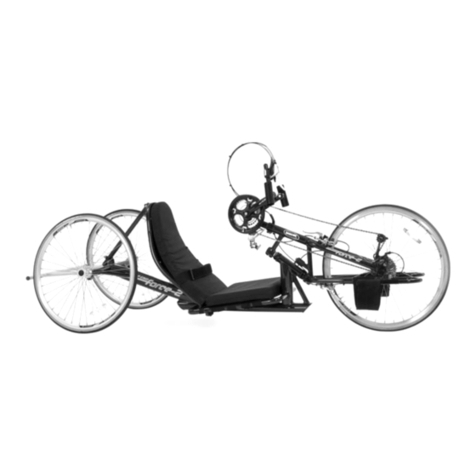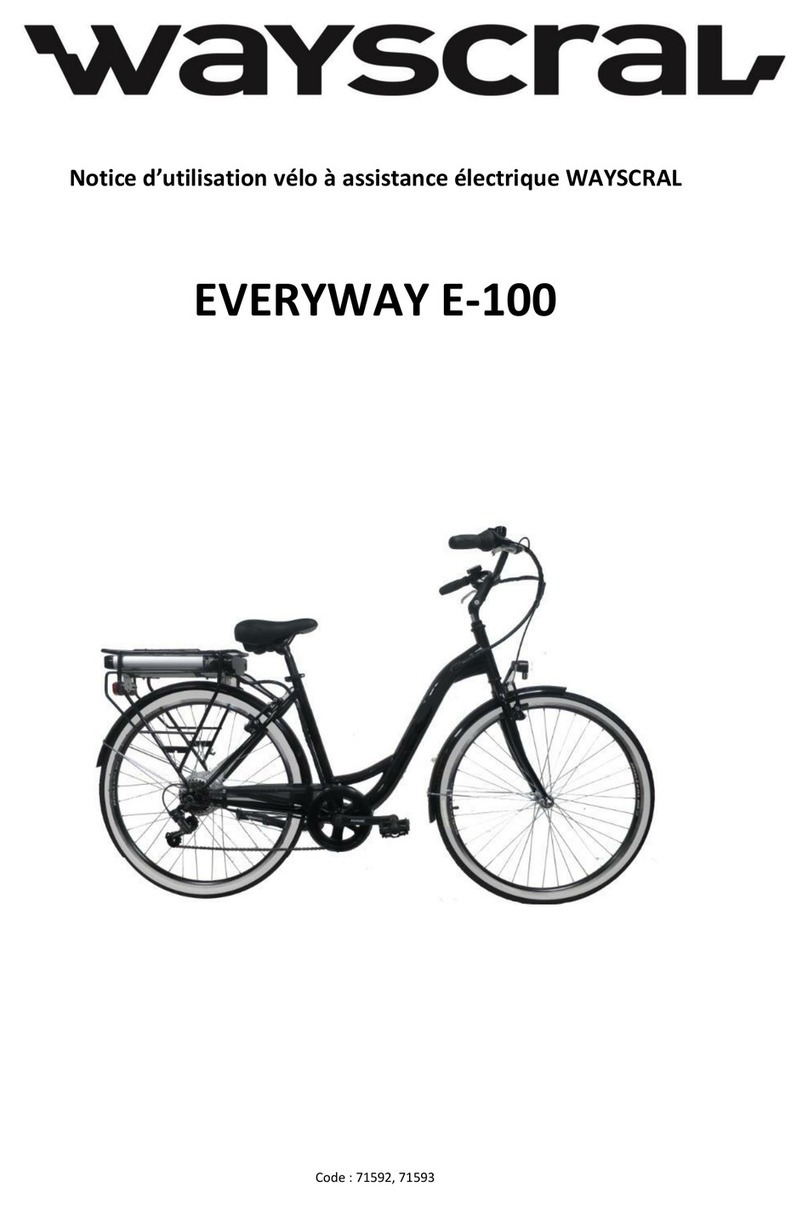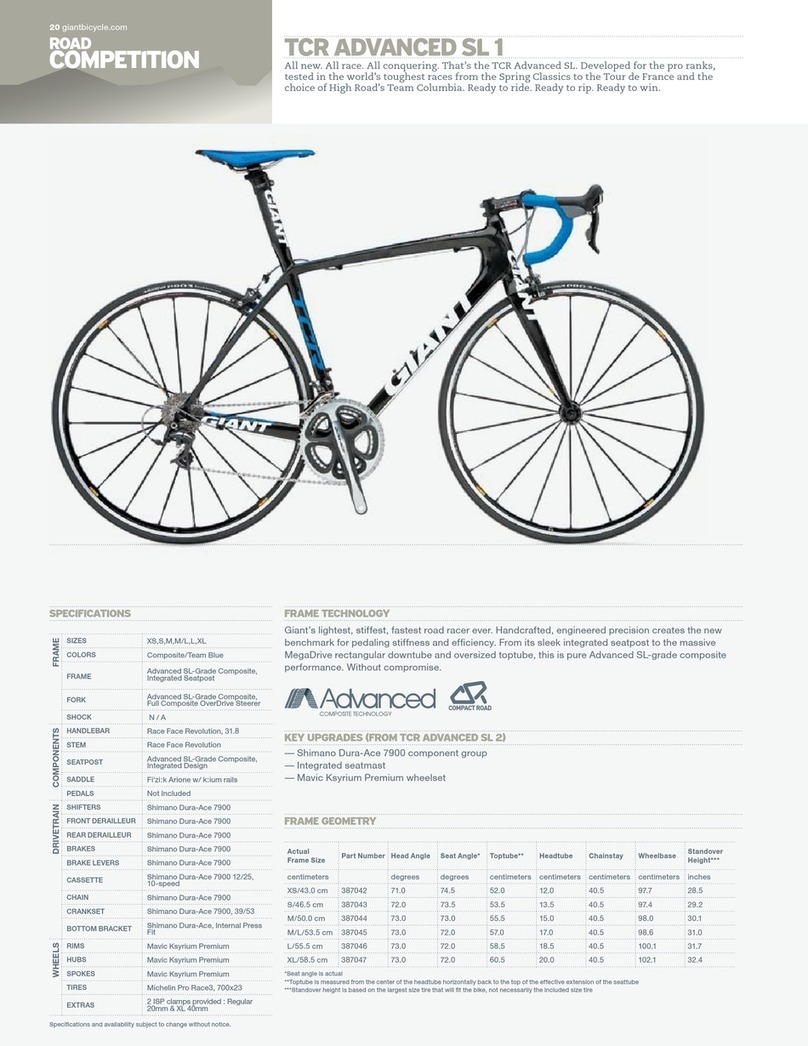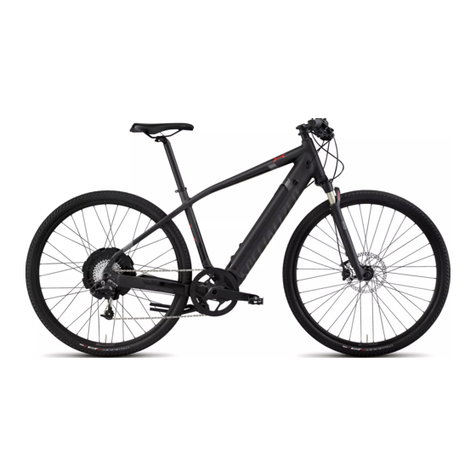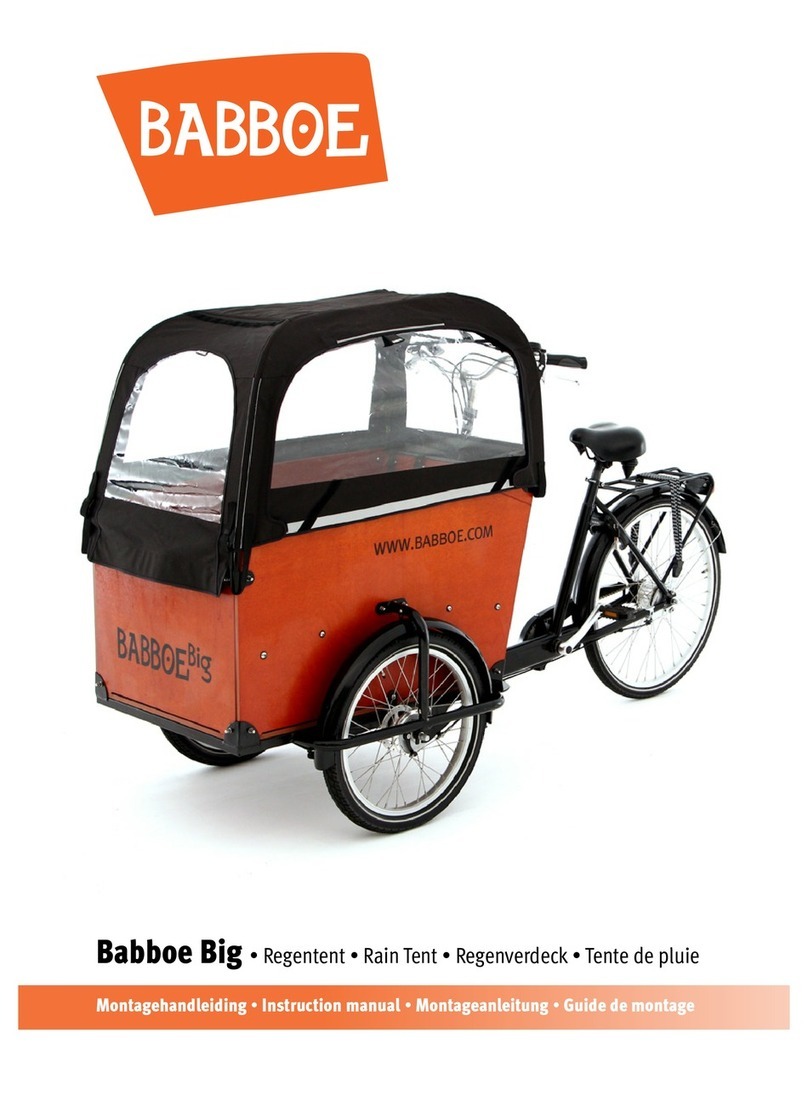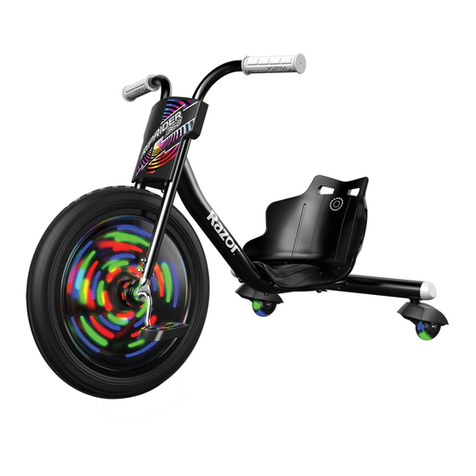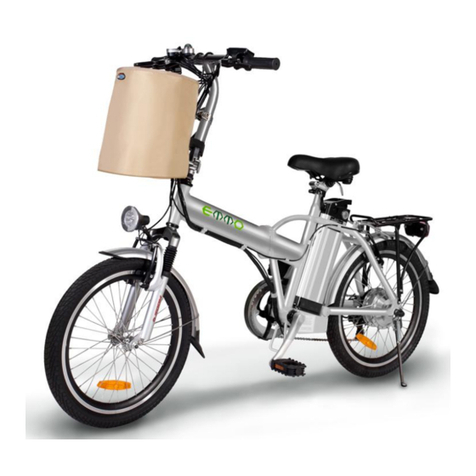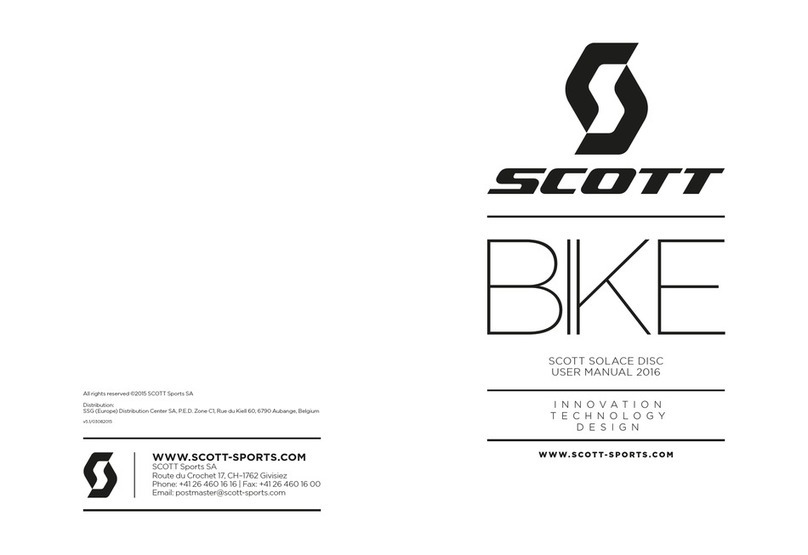FiField Bonfire User manual

INTRODUCTION
i
Electric Bicycle
Owner’s Manual
THIS MANUAL CONTAINS IMPORTANT SAFETY, PERFORMANCE, AND
MAINTENANCE INFORMATION. READ THE MANUAL BEFORE TAKING YOUR
FIRST RIDE ON YOUR NEW ELECTRIC BICYCLE, AND KEEP THE MANUAL
HANDY FOR FUTURE REFERENCE.

INTRODUCTION
ii
About this Owner’s Manual
It is important for you to
understand your new electric
bicycle (e-bike). Even if you have
ridden an e-bike before, it is
important for every person to read
this manual before riding –you’ll
know how to get better
performance, comfort, and
enjoyment from your new e-bike!
Please take the time to read
this manual in its entirety. It is the
owner’s responsibility to carefully
read all of the contents of this
manual and to comply with all laws
pertaining to the operation of
bicycles and/or electric bicycles in
your local jurisdiction.
If the owner is unable to fully
understand this information please
contact Fifield directly for further
explanation.
Register your Electric Bicycle
Due to recent federal
legislation an electric bike is no
longer classified as a motor vehicle.
However, various states have
differing laws about riding them on
the road. These regulations may
include but are not limited to being
at least 16 years of age and/or
having a valid drivers’ license. If
you have any questions regarding
your states legislation please
consult with the Laws web page or
consult your local department of
motor vehicles for clarification.
If you have further questions
about the operation of this e-bike,
consult your authorized dealer or
contact Fifield directly. It is
extremely important that you
follow the safety guidelines
contained in this manual in order
to ensure your maximum safety. If
you loan your bike to anyone make
sure they have also read and fully
understand this owner’s manual.
WARNING
Improper use of this product
may cause serious injury. To
reduce risk of injury please
completely read this manual as
well and reference any
additional bike safety literature
you may have. Fifield assumes
no responsibility for any injury or
property damage incurred
through any use of this product.

IMPORTANT: KEEP FOR FUTURE REFERENCE
3
My bicycle model: _____________________________________________
My frame serial number: _________________________________________
My motor serial number:_________________________________________
My dealer and #: _______________________________________________
Date of purchase: ______________________________________________
Contact Fifield
72 Sharp Street, Hingham, MA 02043
Welcome to the Fifield e-Bike family!
Keep for your records

TABLE OF CONTENTS
iv
Before your first ride Pg. 1 –4
Congratulations!
Know your electric bike
Check before riding
Taking off
Safe riding Pg. 5 –6
Local riding laws
Safety precautions
Varying riding conditions
Assembly Pg. 7 –14
Handlebars
Pedals
Gear alignment
Registration
Instructions for Use Pg. 15 –20
Switching ON/OFF
LCD display screen
Clearing the Trim Time and Distance
Pedal assist
Throttle
Gears
Proper battery usage
Charging the battery
Maintenance Pg. 21 –23
Wheels
Gears
Throttle
Rims
Spokes
Tires
Handlebars
Brakes
General maintenance
Warranty Pg. 24
Fifield Limited Warranty

BEFORE YOUR FIRST RIDE
1
Congratulations!
You are now the proud owner of a
Fifield Electric Bicycle!
Your electric bicycle is like any
other bike, but with electric pedal
assistance and throttle. The same
precautionary steps while biking
should be taken to prevent any
accidents or injuries.
“Electric” means that your
e-bike will assist you when you are
pedaling if you so choose. You may
also pedal normally with no
assistance at all or twist a throttle
to get moving with no pedaling
necessary.
The electric bicycles' amount
of assistance will depend on what
level you set it to; the speed varies
from 0 to 6. The fastest speed your
bicycle will go is 20 MPH (32 Km/h).
Know your electric bicycle
If misused, the features of your
electric bicycle may cause you to
lose control of the e-bike. Before
riding in fast or more difficult
situations, learn the function and
performance of all the mechanisms
of your bike by riding at slower
speeds in a flat, empty space.
The maximum weight is 286lbs
(130 kg). When riding, please pay
attention to the weather and load
on your bike; if any changes are
noticed adjust your riding style
accordingly. When it is raining or
snowing, please increase braking
distance as a safety precaution.
This e-bike is not afraid of rain
or snow, but it cannot be
submerged in water. When water
submerges the motor it can cause
a short circuit to occur and
damage the electric apparatus.
In addition, the exposed metal
contacts on the battery box are
able to carry a charge and cannot
be touched at the same time with
wet hands or metal objects. If this
occurs it may cause a short circuit
or injury.
CAUTION
Charge your battery fully before
using.

2

3
Check your e-bike before riding
everytime
Before operating your electric
bicycle, inspect it carefully to avoid
accidents or damage. Inspect your
bike completely before each ride.
Turning the power on and then
accidentally twisting the throttle
can result in the e-bike lurching
forward and may cause an
accident, damage, or injury.
If the battery was removed,
place the battery back into its
location and be sure to lock it and
remove key. Check to see that the
battery is fully charged (battery
level indicated on screen) before
riding and check the air pressure of
the tires (45 –50 psi). Be sure to
test the front and back brakes, as
well as the condition of the
handlebars and the front and back
wheels.
Make sure that everything is
fastened and secure. Be sure to
check that all quick releases are
locked and in good working order.
Taking off
As the bike starts, accelerate
slowly; do not try to get to your
maximum speed right away
because doing so could damage
the electric components.
If applied, the hand brake will
automatically cut the power to the
motor as well as release the
throttle. You should avoid using
the throttle while brakes are
being applied so that you do not
overload the motor. When starting
from an elevated path, pedal as
much as possible so that the
electric power will last longer.
Pedaling more than using solely
the throttle will lenghten the life of
the battery and motor.
Going downhill
When going downhill, please
do not turn the power off. If you
are not pedaling or using the
throttle, there will be no power
assist when traveling downhill. If
you turn the power off, it could
easily damage the controller and
motor.
CAUTION
Always keep the power switched
OFF before riding. Turn on only
after you are ready to ride.
WARNING
Do not leave the key in the
battery lock while riding to avoid
breaking the key.

4
As you continue to ride, the
battery will decrease
porportionally based on the
amount of power you are using. As
the battery decreases, the bar will
go down one by one. If the bar
goes out completely, you can still
pedal your e-bike just like a regular
bike. Be sure to charge your
battery when you get to an
electrical outlet.
To get the best distance out of
your electric bike, refrain from
excessive stop and go braking and
coast as much as possible.

SAFE RIDING
5
Local riding laws
Most state and local areas
have specific laws for cyclists.
Please check with your local
Department of Motor Vehicles for
clarification. Again, these e-bikes
are not considered motor vehicles,
but may be subject to additional
regulation based on the state you
live in. Some of the common laws
include mandatory lights and
reflectors on the bikes.
Safety precautions
Be sure to ride an appropriate
distance away from cars,
pedestrians, and other obstacles.
In addition, try to avoid potholes,
drain grates, and other
imperfections in the road which
may affect your ability to ride. A
bell is provided to alert others of
your approach.
OBEY all traffic laws relevant to
the operation of bicycles and
electric bicycles.
KEEP both hands on the
handlebars at all times and do not
hang objects from the handlebars.
RIDE predictably and in a straight
line. Never ride against traffic.
USE the correct hand signals when
turning or stopping. If you do not
know the proper hand signals, it is
important you learn them before
riding on the road.
USE extreme caution when you are
near other vehicles. Ride
defensively and assume that other
people on the road do not see you,
and be careful at intersections
when starting from a stopped
position.
DO NOT suddenly brake in the rain
or on slippery surfaces.
WEAR a helmet for your protection
and bright or reflective clothing to
make you more visible.
DO NOT wear lose clothing
because it can get caught in the
bicycle.
When going over train tracks, be
sure to ride perpendicular to the
tracks or walk your bicycle across.

6
Varying riding conditions
Wet conditions
Like any other moving object,
when it is wet or snowing, there is
less traction. This applies
specifically to the brakes on the
bike; they will not perform as well
as they do in dry climates. Be sure
to brake earlier because it will take
a longer distance to come to a full
stop. Ride at a slower speed and
try to be more visible.
Low visibility
Even though your bicycle
comes with headlights, rear lights,
and reflectors, in situations where
there is low lighting it may make it
difficult for people to see you. Be
sure to see and be seen in your
environment. Wear reflective and
bright colored clothing to enhance
visibility for others.

ASSEMBLY
7
You will need:
Two Allen Wrenches 15mm Wrench
(4mm and 5mm)
Phillips Head Screwdriver
IMPORTANT: We highly recommend you do not attempt to assemble
yourself, please bring to your local bike shop. These assembly
instructions are designed for the use of a trained professional and should
not be used if you do not have experience assembling a bicycle. Improper
assembly can lead to broken pieces, malfunctioning components, and
serious injury. These step by step instructions cover the majority of
assembly required but will not include details such as chain correction
and proper brake adjustment; these changes should only be done by a
professional.
Safety note: Keep all small pieces, plastic wrap, and sharp edges away
from small children. Exercise caution while working with any tools and
electrical components.

8
1. Use the 4mm allen wrench and
remove the headlight. Do not
disconnect any cables, only
remove the single bolt and
washer keeping the headlight
connected to the fork (shown
below) and allow the headlight
to hang freely. This bolt and
washer will be used later; set it
aside and be sure not to
misplace it.
2. Use the Phillips head screwdriver and remove the fork lock from
the frame. The lock is located on the frame where the handlebars
will later be placed. When this lock is removed the fork will not be
secured to the frame and can be easily removed. After removal,
the lock will not be used again and can be discarded. Please be
aware that if the fork accidently slips out this is not a problem, to
resolve simply slide it back into place and reinsert the spacers
into their original positions (shown below).

9
3. Properly align the handlebars so the brakes are facing outward
and put them into place over the frame. Push downward until no
silver is showing on the frame. To tighten, use the 5mm allen
wrench and tighten the top bolt until it is securely in place.
4. The handlebars are currently
positioned at a 90 degree
angle; bring the handlebars
to a straight position
perpendicular to the ground.
Locate the two4mm bolts on
the side of the handlebars.
These bolts are used to lock
the handlebars in place.
Make sure that the
handlebars are in an
appropriate riding position
with the fork and use the
allen wrench to tighten.

10
For steps 5 -7 we recommend you turn the bicycle up-side down and
balance the bike on the handlebars and the seat.
5. The front wheel has 4 parts which will hold the wheel in place
while riding. These parts are a bearing, washer, lock washer, and
nut. On each side, remove the washer, lock washer, and nut and
place them aside; leave the bearing in place. (The bearing is a
circular piece with a small rectangular extension shown in step
6).
Note: the circular object on the wheel is the disk braking system (also
depicted above). In its current position, if the bike is facing forward, this
disc should be placed on the right side in between the brake pads.
Washer
Nut
Lock
washer

11
6. To set the wheel in place line up the rectangular piece of the
bearing with the corresponding rectangular slot in the fork (as
shown below). Gently press down on the wheel until it falls
snugly into place. You may need to pull the fork apart slightly if
you cannot get the wheel to fit properly with constant easy
pressure. A proper connection is shown below.
7. Place the washer over the bolt, followed by the lock washer, and
finally tighten the nut to secure the wheel properly. Use a 15mm
wrench to tighten. When both nuts are fully tightened, return the
bike to its original upright position and put the kickstand down
for the remainder of assembly.

12
8. Locate the wire coming from the motor shown below (located
near the front wheel) and the wire attached to the fork. Align the
two arrows shown below and push the connection together until
a click is heard. Failure to align the arrows properly will damage
the bike. The horizontal black line should be covered completely
by the other wire to ensure a full connection is made. To check,
turn on the battery. If error code 24 is displayed in the bottom
right corner then the connection is not complete. If the error
code 24 appears briefly then disappears the connection is
complete. On the side there is a small Phillips head screw; use this
to attach the cable to the fork and secure it in place.
9. Locate the front fender. There is a small metal piece extending
from the top of the fender; this extension is the center and will
be used to hold the fender and front light in place. To attach both
the light and the fender, put
the light back in its original
position and insert the
fender from the back until
the metal clip is over the
light extension. The image
shows the proper order for
installation (note: this
picture was taken from the
front of the wheel). When
complete use a 4mm allen
wrench and tighten.

13
Note: When looking at the metal extension the fender has a short end
and a long end. The long end goes to the back of the wheel to protect
your legs from water, dirt, etc.
10. To finish fender installation the
extensions holding the fender
to the fork must also be
tightened. To do this, locate
the bolts shown to the right
and the free extensions on the
fender. Attach the extensions
as shown below and tighten
with a 4mm Allen wrench to
hold the fender in place.
11. Locate the pedals. Each pedal will be marked with a distinctive “L”
and “R” which represents the left and right pedal respectively.
Place the left pedal on the left side of the bike and tighten the
pedal in place. Repeat this process for the right pedal. To ensure
the pedals will not slip, use your 15mm wrench to continue to
tighten.
12. Congratulations! Your bike is completely assembled and ready to
ride. However, before you ride we also recommend making a
couple adjustments to your bike to make sure the ride is perfect.
We do not recommend you make these adjustments yourself.

14
Instead, present these instructions to your local bike shop owner.
a. Brakes: You may find your brakes
are rubbing against the spokes or
making noises when the wheel is
first installed. These small noises
are normal when you first start
riding the bike. However, if you
feel it is an issue brake
adjustment can be done using a
5mm Allen wrench in the bolts
shown to the right. Tighten and
loosen these bolts until the
brakes are in their proper
position.
b. You may also notice that your hand brakes are not as tight as you
would like. To adjust the brake sensitivity, turn the small knobs
located on the sides of the handlebars until you find a suitable
level of responsiveness.
c. The fenders may also need adjustment from the wheel. If you
find the fender is rubbing against a wheel, loosen the Phillips
head screw and extend the rod further (this screw is shown in
the image under step 10). Retighten to hold the fender back in
place. If the fender is not properly aligned with the wheel you can
also loosen the screw at the other end of the rod and they will be
able to move freely. Move the fender rod to the proper position
and retighten.
13. Registration: When assembly is complete, please refer to our
website to register your new electric bicycle! On the site, you will
be prompted to answer a few brief questions and provide two
serial numbers. The first, the frame serial number is located
directly below the handlebars and above the front wheel on the
front of the bike. The second, the motor serial number is written
on the motor, located in the center of the front wheel.

INSTRUCTIONS FOR USE
15
Switching ON/OFF
Make sure your battery is secure and locked in place and remove the
key from the battery. To turn the system on, go to the LCD screen hold
down the MODE for 2 seconds. To turn off, hold MODE for an additional 2
seconds.
When the e-bike is parked for more than 10 minutes, the display will
automatically shut down.
LCD display screen
The display screen will only work when the battery is attached to the
bike.

16
LCD Function Summary
The LCD screen provides a
wide range of functions and
indicators to the fit your needs.
The indicated contents are as
follows:
Battery level indicator
Speed display
Trip distance and total distance
Cruise control (when walking)
Headlight on/off
Motor power (wattage)
Trip distance and total distance
The LCD has three buttons.
MODE UP DOWN
Display Interface
After starting up the display,
the default setting will show
Running Speed. Press MODE to
change the information from
Running Speed to Average Speed,
Max Speed, Trip Distance, Total
Distance, and Trip Time.
Cruise Control
Press and hold DOWN to
enable power assistance while
walking the bicycle. Your bike will
go at a speed of 3.7 MPH (6
KmPH).
NOTE: This function can only be
used while pushing/walking the
electric bike by hand. Please do not
use this function while riding.
Backlight On/Off
Hold UP for 2 seconds to turn
on the backlight of the display; this
will also power on the headlight.
Hold UP again for 2 seconds to
turn off.
Power Assist Level Selection
Press UP or DOWN to change
desired output of power. The
power ranges from 0-6. Level 0 will
supply no power to the pedal
assist and level 6 will supply the
maximum. The default value is
level 1 though you will be able to
shift freely at any time. Your
current level of power assist can
be seen in the bottom left corner
of the LCD screen labeled as
“PAS”.
CAUTION
Try to avoid hitting the screen.
Do not try to modify the system
parameters as it may cause
malfunctions.
WARNING
Contact service center if an error
code is displayed. Do not attempt
to fix it yourself.
Table of contents
Other FiField Bicycle manuals
